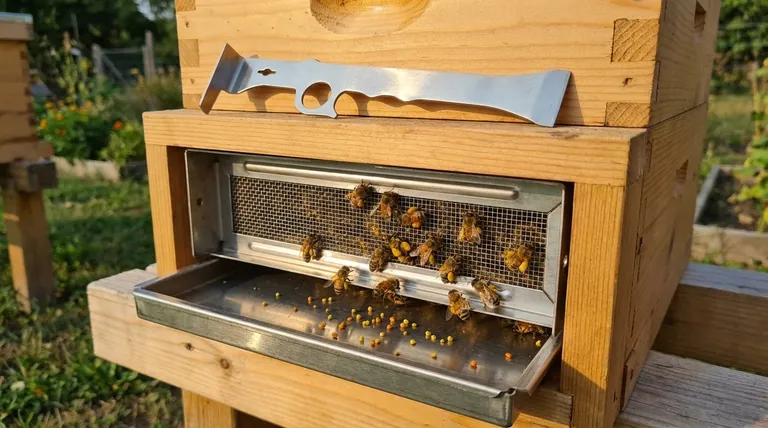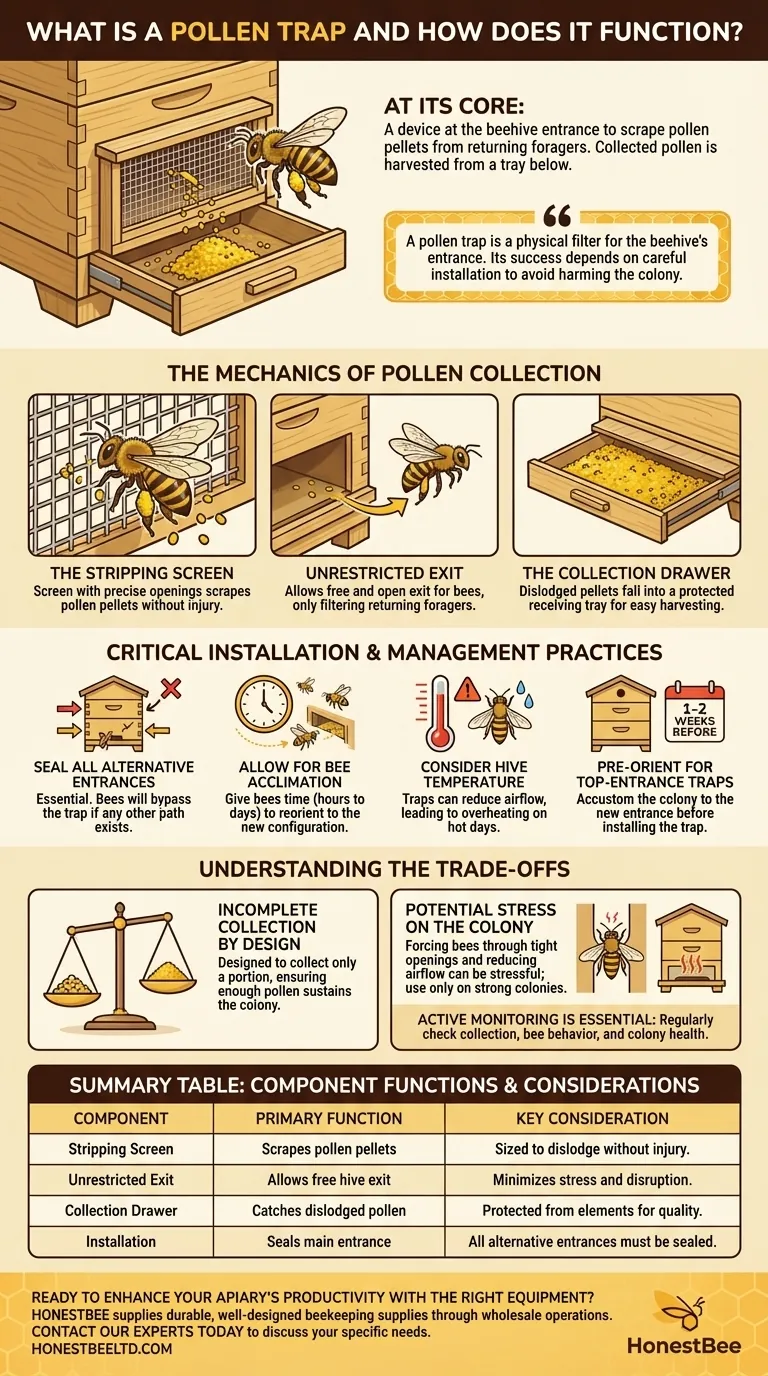At its core, a pollen trap is a device fitted to a beehive entrance that scrapes pollen pellets from the legs of returning forager bees. As bees are forced to crawl through a screen or a set of small openings to re-enter the hive, the pollen they've collected is dislodged and falls into a collection tray below for harvesting.
A pollen trap is a physical filter for the beehive's entrance. Its purpose is to intercept a portion of the incoming pollen, but its successful use depends entirely on careful installation and management to avoid harming the colony's health and productivity.

The Mechanics of Pollen Collection
To understand how to use a pollen trap effectively, you must first understand its simple but precise components. Each part is designed to interact with the bees' natural foraging behavior.
The Stripping Screen
The heart of the trap is a screen with openings just large enough for a bee to squeeze through. As a returning forager, laden with pollen packed onto her hind legs, pushes through the opening, the edges of the screen scrape the pollen pellets off.
These pellets are the target of the harvest. The screen is designed to dislodge them without causing injury to the bee herself.
Unrestricted Exit
A well-designed trap does not impede bees leaving the hive. It creates a system that allows for a free and open exit, only filtering the traffic of returning foragers. This one-way restriction is critical for minimizing stress and disruption to the colony's daily operations.
The Collection Drawer
Once scraped from the bees' legs, the pollen pellets fall through the screen and land in a drawer or receiving tray. This tray is typically protected from the elements and allows the beekeeper to easily remove the collected pollen without further disturbing the hive.
Critical Installation & Management Practices
Simply placing a trap on a hive is not enough; incorrect implementation can harm your bees. Following best practices is essential for both a successful harvest and the well-being of the colony.
Seal All Alternative Entrances
This is the most critical step. Bees will always choose the path of least resistance. If any other cracks or openings exist, the bees will use them to bypass the trap, rendering it completely ineffective.
Allow for Bee Acclimation
The trap fundamentally changes the hive's entrance. Bees will need time, from several hours to a few days, to adjust to this new configuration. You must monitor the entrance to ensure they are successfully reorienting and not becoming overly congested.
Consider Hive Temperature
By partially blocking the main entrance, a pollen trap can reduce airflow. On hot days, this can lead to overheating inside the hive. It is wise to install traps on cooler days and to monitor the colony for signs of heat stress.
Pre-orient for Top-Entrance Traps
If you are using a trap designed for a top entrance, you must get the colony accustomed to using that entrance for 1-2 weeks before you install the trap itself. This prevents mass confusion among the returning foragers.
Understanding the Trade-offs
A pollen trap is an intervention in the colony's natural lifecycle. Understanding its impact is key to using one responsibly.
Incomplete Collection by Design
An effective trap does not capture all the pollen. It is designed to only collect a portion, ensuring that enough pollen still gets into the hive to feed the brood (bee larvae) and sustain the colony. A 100% effective trap would starve the hive.
Potential Stress on the Colony
Forcing bees through a tight opening and reducing ventilation can be stressful. This is why traps should only be used on strong, healthy, and populous colonies that can easily withstand the minor disruption. Never use a trap on a weak or struggling hive.
The Need for Active Monitoring
Using a pollen trap turns you from a passive observer into an active manager. You must regularly check the collection tray, monitor the bees' behavior at the entrance, and periodically inspect the brood to ensure the colony remains healthy and productive.
Making the Right Choice for Your Hive
A pollen trap can be a valuable tool, but only when used with a clear understanding of its purpose and consequences.
- If your primary focus is harvesting pollen: Ensure your colony is strong, install the trap correctly by sealing all other entrances, and monitor the hive's health closely to ensure your harvest is sustainable.
- If your primary focus is colony health and honey production: Recognize that a pollen trap adds a management burden and should only be deployed on robust colonies when you have a specific need for pollen.
By understanding the pollen trap as both a tool and an intervention, you can make a strategic decision that benefits both your goals and your bees.
Summary Table:
| Component | Primary Function | Key Consideration |
|---|---|---|
| Stripping Screen | Scrapes pollen pellets from returning foragers' legs. | Must be sized to dislodge pollen without injuring bees. |
| Unrestricted Exit | Allows bees to leave the hive freely. | Minimizes stress and disruption to colony operations. |
| Collection Drawer | Catches dislodged pollen for easy harvesting. | Should be protected from the elements for quality pollen. |
| Installation | Seals the main entrance to force bees through the trap. | All alternative entrances must be sealed for effectiveness. |
Ready to enhance your apiary's productivity with the right equipment?
As a commercial beekeeper or distributor, efficient and sustainable practices are key to your success. HONESTBEE supplies durable, well-designed beekeeping supplies and equipment through our wholesale-focused operations, helping you manage your hives effectively and maximize your harvest.
Contact our experts today to discuss your specific needs and discover how our pollen traps and other equipment can support the health of your colonies and the growth of your business.
Visual Guide

Related Products
- HONESTBEE Advanced Ergonomic Stainless Steel Hive Tool for Beekeeping
- Professional Dual-End Stainless Steel Hive Tool for Beekeeping
- Professional Galvanized Hive Strap with Secure Locking Buckle for Beekeeping
- Professional 3-Bar Frame Grip with Integrated Hive Tool
- Plastic Bee Hive Stand for Beekeeping
People Also Ask
- What are the basic tools for beekeeping? Essential Starter Kit for Safe & Successful Hive Management
- Why do hive tools have a hole? Unlock the Secret to Efficient Beekeeping
- What are the features of a regular hive tool? The Essential Multi-Tool for Every Beekeeper
- What tools are used for cleaning frames? A Beekeeper's Simple 4-Tool Guide
- What is the hole in a hive tool for? A Multi-Tool for Apiary Repairs and Maintenance



















